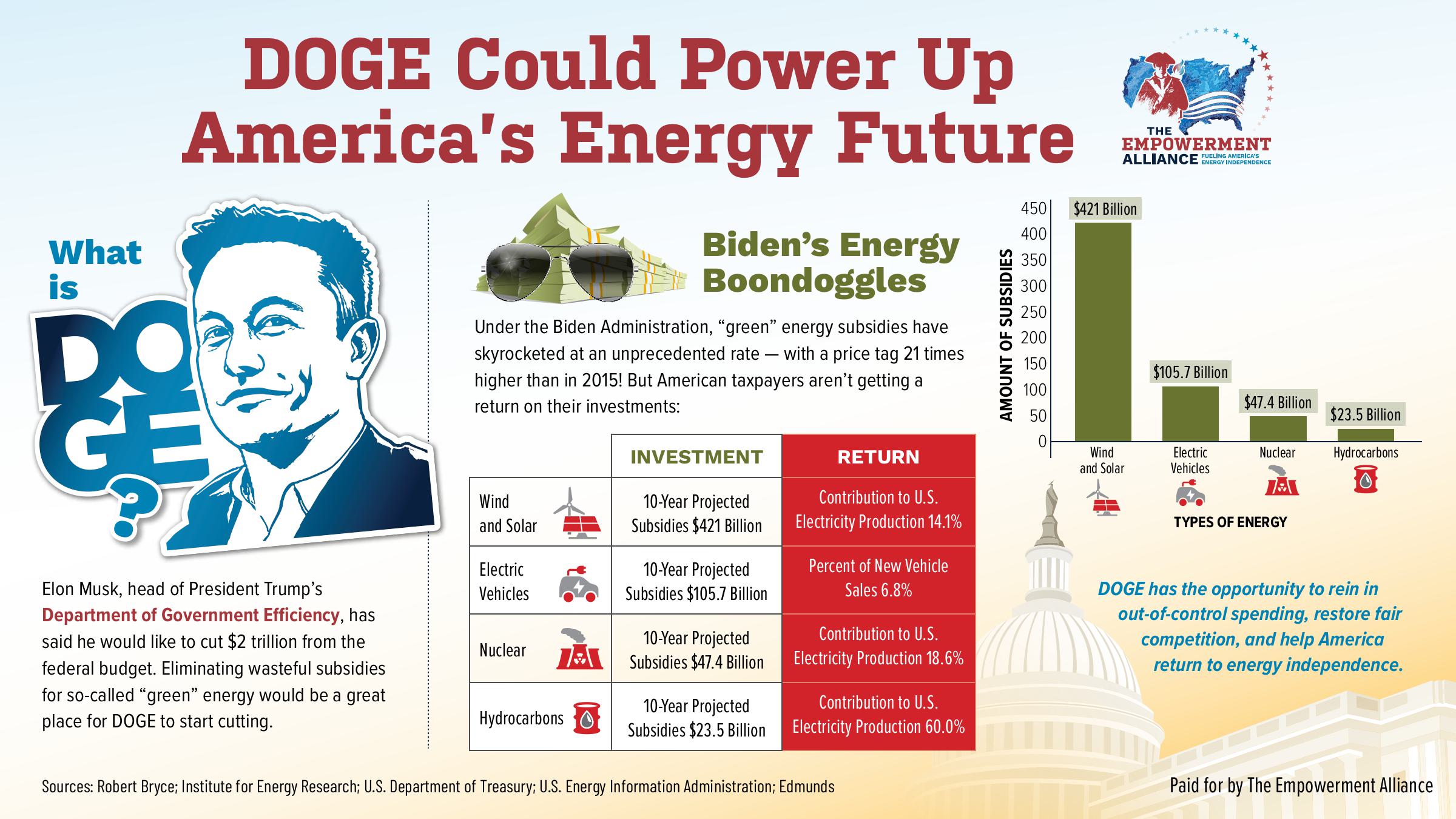Learn

AFTERNOON TEA
Want to cut spending? DOGE should start with subsidies
With a newly inaugurated President Trump and a new Congress taking charge, the mood for change is strong in Washington and throughout the nation. And, in what would be a huge part of that change, Elon Musk, head of President Trump’s Department of Government Efficiency, has said they would like cut $2 trillion from the federal budget. Eliminating wasteful subsidies for so-called “green” energy would be a great place for DOGE to start cutting.
As Biden ended his time in office, his Transportation Department handed out $5 billion for transit projects, including electrical vehicle charging stations, under his 2021 infrastructure law. The White House also doled out more than $100 billion in “green” energy subsidies under the Inflation Reduction Act. Even if you somehow believe that billions and billions of taxpayer dollars being dumped into “green” programs is appropriate, you must admit that it’s doubtful that the projects are being properly vetted with such fast and furious spending. (There’s a nearly decades-long history of government-funded renewable energy and electric vehicle projects going belly up after getting taxpayer dollars with little oversight. See: Solyndra, Fisker, Crescent Dunes.)
Under Biden, “green” energy subsidies skyrocketed at an unprecedented rate—with a price tag 21 times higher than it was in 2015. According to energy author Robert Bryce, the Inflation Reduction Act has “exploded” the investment tax credit and production tax credit. Bryce: “Those credits, which are the principal drivers behind the deployment of wind and solar energy, and a handful of other forms of alt-energy, are, by far, the most expensive energy-related provisions in the federal tax code. Between 2025 and 2034, the ITC and PTC will account for more than half of all energy-related tax provisions. And that total does not include the tax credits for electric vehicles.”
But American taxpayers aren’t getting a return on their investment. While wind and solar energies are projected to get a whopping $421 billion in taxpayer dollars over the next 10 years, they only provide 14% of the electricity produced in the U.S. Electric vehicles are looking at $150.7 billion in subsidies over the next ten years, but only make up 6.8% of new vehicles sold in the U.S. And, that’s because of their expensive price tag—$55,544 as of December 2024—still thousands higher than the average-priced gasoline vehicle and not accessible to everyday American families. That’s right, Americans are forced to subsidize vehicles that they can’t afford to buy.
In contrast, nuclear power will likely receive $47.4 billion from the nuclear power production credit over the next two years. That’s 11% of the handouts to wind and solar. But, nuclear contributes 18.6 % of the electricity produced in the U.S. And, the clear winner of the return on investment for American taxpayers: traditional hydrocarbon sources will get $23.5 billion in credits over the decade—5.6% of the “green” subsidies—while producing a 60% majority of our nation’s power.
So, long story short, affordable “green” energy isn’t affordable. But, we’re still getting the “green” part, right? Not really.
According to Bryce, the green energy incentives in the Inflation Reduction Act “are supposed to begin winding down by 2032 or when the power sector’s emissions are slashed by 75% compared to 2022 levels.” But the Cato Institute has said even with all the “green” spending, those emissions might only go down by about 35% by 2050. Maybe, just maybe, there’s not a lot of incentive for “green” energy producers to truly lower emissions when it means the flow of taxpayer-funded cash gets cut off when they do.
And, the quiet part that the green-at-all-cost crowd doesn’t want to say out loud? U.S. carbon dioxide emissions from power production have already declined 61% due to increased use of natural gas. This is the top reason for U.S. power sector emissions reductions over the past 17 years—almost double the impact compared to renewable power generation.
DOGE has a rare opportunity to do something incredible, that is so rarely done in American politics—effect real change on the way the government works and what it costs the American people. Musk even went so far as to say he’s willing to “get rid of all the credits” including the ones for his Teslas. Eliminating burdensome and ineffective “green” energy subsidies might not cut $2 trillion from the budget immediately, but it’s certainly a solid start. Energy analysts Wood Mackenzie estimated that if left unchecked, the Inflation Reduction Act’s “green” subsidies could cost as much as $3 trillion in the long run.
But, beyond the cost savings, there’s also an opportunity to show a dedication to investing in what truly works. Historically, America has thrived on our ability to build, adapt and prepare for the future in a practical and productive manner. Flippantly dumping billions, even trillions of dollars down the drain, on technologies that just don’t produce, is the antithesis of our American drive.
Picking winners and losers with the subsidy game only takes us further from our ARC Energy Security goal. Energy that fuels America’s productivity is already at our fingertips through sources like American natural gas. DOGE can put the U.S. government back on the path of working for the American people and securing our affordable, reliable and clean energy future.
The Empowerment Alliance was formed in 2019 to offer common-sense energy solutions that promote production and consumption of Affordable, Reliable, Clean natural gas. We believe that our nation’s energy independence is essential for America’s independence.



